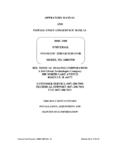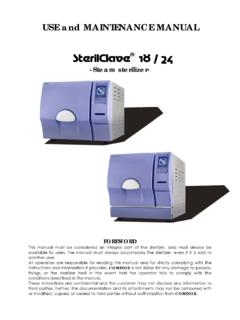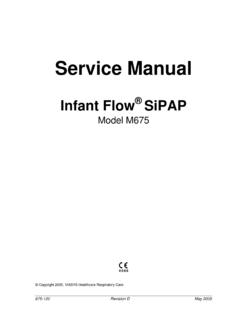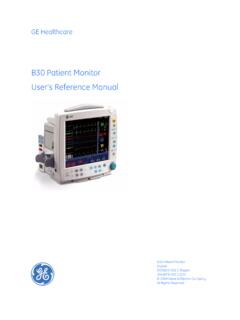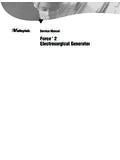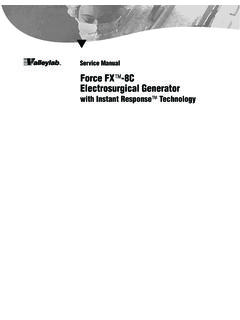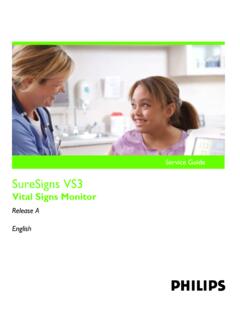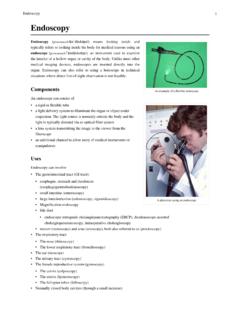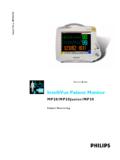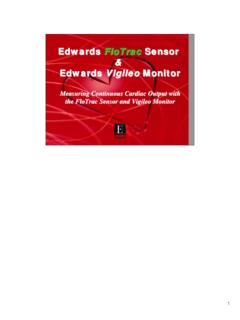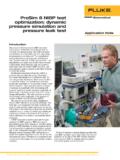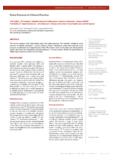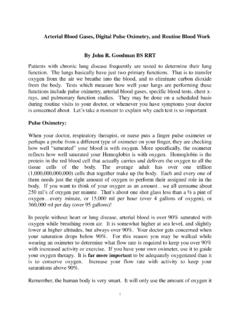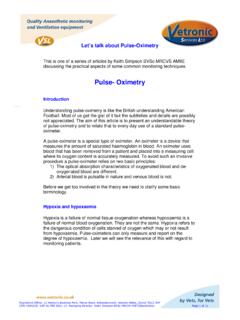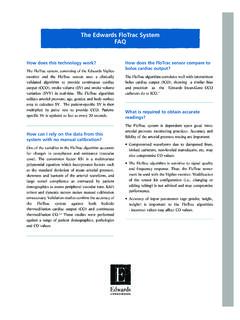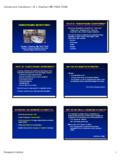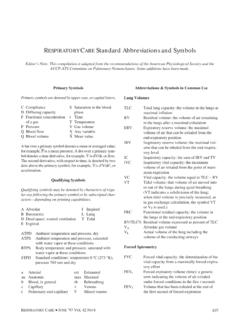Transcription of Pulse pressure - Frank's Hospital Workshop
1 Pulse pressure1 Pulse pressurePulse pressure is the difference between systolic and diastolic blood pressure , or the change in blood pressure seenduring a contraction of the it is the systolic pressure minus the diastolic pressure .[1]Theoretically, the systemic Pulse pressure can be conceptualized as being proportional to stroke volume andinversely proportional to the compliance of the aorta[2] . Systemic Pulse pressure = Psystolic - Pdiastolic = 120mmHg - 80mmHg = 40mmHg Pulmonary Pulse pressure = Psystolic - Pdiastolic = 25mmHg - 10mmHg = 15mmHgValues and variationLow valuesIn trauma a low or narrow Pulse pressure suggests significant blood loss.[3] In an otherwise healthy person adifference of less than 40 mmHg is usually an error of measurement. If the Pulse pressure is genuinely low, 25mmHg or less, the cause may be low stroke volume, as in Congestive Heart Failure and/or shock, a serious interpretation is reinforced if the resting heart rate is relatively rapid, 100-120 (in sinus tachycardia),reflecting increased sympathetic nervous system activity as the body's response to low stroke volume and lowcardiac output.
2 A narrow Pulse pressure can also be caused by aortic : (these are examples of WIDENING Pulse pressure causes) Atherosclerosis Chronic aortic regurgitation Thyrotoxicosis Fever Anaemia Pregnancy Anxiety Heart block Aortic dissection Endocarditis Raised intracranial pressureHigh values during or shortly after exerciseUsually, the resting Pulse pressure in healthy adults, sitting position, is about 40 mmHg. The Pulse pressure increases with exercise due to increased stroke volume[4] , healthy values being up to Pulse pressures of about 100 mmHg, simultaneously as total peripheral resistance drops during exercise. In healthy individuals the Pulse pressure will typically return to normal within about 10 minutes. For most individuals, during exercise, the systolic pressure progressively increases while the diastolic remains about the same.
3 In some very aerobically athletic individuals, for example distance runners, the diastolic will progressively fall as the systolic increases. This behavior facilitates a much greater increase in stroke volume and cardiac output at a lower mean arterial pressure and enables much greater aerobic capacity and physical performance. The diastolic drop reflects a much greater fall in total peripheral resistance of the muscle arterioles in response to the exercise (a greater proportion of red versus white muscle tissue). Individuals with larger BMI's due to increased muscle mass (body builders) have also been shown to have lowerPulse pressure2diastolic pressures and larger Pulse pressures.[5]Consistently high valuesIf the usual resting Pulse pressure is consistently greater than 40 mmHg, 60 or 80 mmHg, the most likely basis isstiffness of the major arteries, aortic regurgitation (a leak in the aortic valve), arteriovenous malformation (an extrapath for blood to travel from a high pressure artery to a low pressure vein without the gradient of a capillary bed),hyperthyroidism or some combination.
4 (A chronically increased stroke volume is also a technical possibility, butvery rare in practice.) While some drugs for hypertension have the side effect of increasing resting Pulse pressureirreversibly, other hypertension drugs, such as ACE Inhibitors, have been shown to lower Pulse pressure . A highresting Pulse pressure is harmful and tends to accelerate the normal aging of body organs, particularly the heart, thebrain and kidneys. A high Pulse pressure combined with bradycardia is associated with increased intracranialpressure and should be reported to a physician to heart diseaseRecent work suggests that a high Pulse pressure is an important risk factor for heart disease. A meta-analysis in2000, which combined the results of several studies of 8,000 elderly patients in all, found that a 10 mm Hg increasein Pulse pressure increased the risk of major cardiovascular complications and mortality by nearly 20%.
5 [6]Heightened Pulse pressure is also a risk factor for the development of atrial fibrillation.[7] The authors of themeta-analysis suggest that this helps to explain the apparent increase in risk sometimes associated with low diastolicpressure, and warn that some medications for high blood pressure may actually increase the Pulse pressure and therisk of heart measurementPulse pressure readings can be taken on a home monitoring blood pressure device. Most home monitoring bloodpressure devices display systolic and diastolic blood pressure and Pulse pressure readings. Monitoring at home willmeasure true Pulse and blood pressure and provide a doctor with a log of readings over the patient suffers from elevated Pulse pressure , treatment should include medication that addresses this factor,such as an angiotensin-converting enzyme inhibitor (ACE inhibitor).
6 [8]Effect of folic acidA 2005 study found that 5 mg of folate daily over a three-week period reduced Pulse pressure by mm of Hgcompared with a placebo, and concluded that Folic acid is an effective supplement that targets large artery stiffnessand may prevent isolated systolic hypertension.[9]See also Blood pressure Mean arterial pressure Cold pressor test Hypertension Prehypertension Antihypertensive Patent ductus arteriosusPulse pressure3 References[1]http:/ / wiki. answers. com/ Q/ Why_is_mean_arterial_pressure_not_equal_ to_systolic_pressure_minus_diastolic_pre ssure_dived_by_2[2]Arterial Pulse pressure (http:/ / www. cvphysiology. com/ Blood pressure / BP003. htm)[3]American College of Surgeons (2008). Atls, Advanced Trauma Life Support Program for Doctors. Amer College of Surgeons. pp. 1-880696-31-6.[4](http:/ / www. pps. org. pk/ PJP/ 3-2/ 07-Farida.)
7 Pdf)[5](http:/ / hyper. ahajournals. org/ cgi/ content/ full/ 33/ 6/ 1385?maxtoshow=& HITS=10& hits=10& RESULTFORMAT=& fulltext=arterial&searchid=1& FIRSTINDEX=60& resourcetype=HWFIG)[6]Blacher J, Staessen JA, Girerd X, Gasowski J, Thijs L, Liu L, Wang JG, Fagard RH, Safar ME. Pulse pressure not mean pressure determinescardiovascular risk in older hypertensive patients. Arch Intern Med 2000 Apr 24;160(8):1085-9. PMID 10789600[7] Pulse pressure Important Risk Factor for the Development of New-Onset AF CME http:/ / www. medscape. com/ viewarticle/ 552468[8] Pulse pressure Builds Steam as Mortality Predictor - Brief Article - Statistical Data Included http:/ / findarticles. com/ p/ articles/ mi_m0 BJI/is_1_30/ ai_59457655hypertensive patients with high Pulse pressures should include a drug that is effective at reducing pulsepressure, and angiotensin-converting enzyme inhibitors are the best for this purpose.
8 [9]Carolyn Williams, Bronwyn A Kingwell, Kevin Burke, Jane McPherson and Anthony M Dart: Folic acid supplementation for 3 wk reducespulse pressure and large artery stiffness independent of MTHFR genotype. American Journal of Clinical Nutrition, Vol. 82, No. 1, 26-31, July2005 http:/ / www. ajcn. org/ cgi/ content/ full/ 82/ 1/ 26 Article Sources and Contributors4 Article Sources and ContributorsPulse pressure Source: Contributors: 1 ForTheMoney, Aesopos, Agentdenim, Anespa, Arcadian, Brummfuss, D6, Dpen2000,Dreamyshade, Epbr123, Fibrosis, Fredrik, Frycow, Goodnightmush, Jfdwolff, Jmbigwood, Jmh649, John254, Ksheka, Ladida, Luna Santin, MAlvis, MastCell, Monitorer, Nodekeeper,Notepadpage, Orlandoturner, Pol098, Prisonblues, Ptdecker, Ryanjc559, ShakingSpirit, Thorwald, Topgunner, Woohookitty, 55 anonymous editsLicenseCreative Commons Attribution-Share Alike Unportedhttp:/ / creativecommons.
9 Org/ licenses/ by-sa/ 3. 0/
